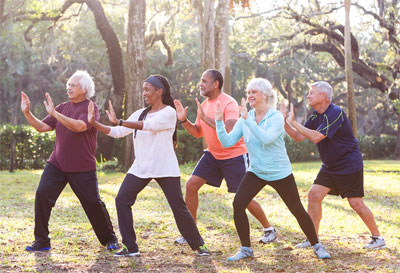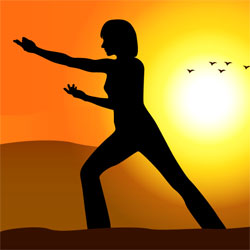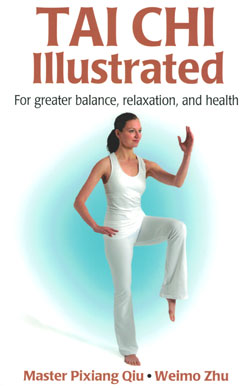|
Tai Chi
Author:
Stan Reents, PharmD
Original Posting:
04/23/2019 09:03 AM
Last Revision: 02/24/2021 08:19 AM
Years ago, yoga surged in popularity in the US. I predict the same thing is about to happen with Tai Chi! DESCRIPTION Tai Chi (also referred to as Tai Chi Chuan, Tai Ji Quan) is an activity that blends slow, rhythmic movements with meditation. It originated in China thousands of years ago but, today, it is commonly performed by Americans. Tai chi evolved into several distinct styles: Chen, Sun, Wu, and Yang. Of these, Chen is the oldest, while Yang is the most popular. Jane Brody, a health journalist for The New York Times, has written about the health benefits of tai chi. She describes it as follows: • Tai chi is a low-impact activity suitable for people of all ages and most states of health, including those who have long been sedentary or "hate" exercise. It involves deep breathing but does not work up a sweat or leave you out of breath. • Tai chi does not place undue stress on joints and muscles and therefore is unlikely to cause pain or injury. • Tai chi requires no special equipment or outfits, only lightweight, comfortable clothing. • Once proper technique is learned from a qualified instructor, tai chi is a low-cost activity that can be practiced anywhere, anytime. Sounds pretty good. But can performing tai chi regularly reduce the risk of health problems?... HEALTH BENEFITS OF TAI CHI Improving balance and reducing stress may come to mind first when considering tai chi. However, tai chi can provide additional health benefits. I was surprised to discover that quite a lot of research has investigated the health benefits of tai chi. In 2004, researchers from Tufts-New England Medical Center (Boston) and McGill University (Montreal) published an extensive review of this research. They identified 47 clinical studies worth evaluating (Wang C, et al. 2004). Here's what they concluded: • Balance, Falls (7 clinical studies): As little as 8 to 16 weeks of tai chi improved balance, flexibility, and thigh muscle strength, and, reduced the occurrence of falls in community-dwelling elders. • Mood, Psychological Well-Being (6 studies): Subjects in all 6 studies of the effects of tai chi on mood showed improvement. In 4 studies, improvements were seen in depression, stress and anxiety, life satisfaction, and perception of health. One study evaluated a 12-week tai chi program in children in grades 4-6. Scores on perceived self-competence and visual-motor tests improved. One final study showed cognitive improvement in patients with multiple-infarct dementia or Alzheimer's disease. • Hypertension (4 studies): Average blood pressure was reduced in subjects who practiced tai chi in all 4 studies. In one study, tai chi was compared to aerobic exercise. Both were performed 4 times per week for 30 minutes per session. After 12 weeks, both types of exercise reduced blood pressure (Young DR, et al. 1999):
| BLOOD PRESSURE | AEROBIC EXERCISE | TAI CHI | | • Systolic BP | decreased 8.4 points | decreased 7.0 points | | • Diastolic BP | decreased 3.2 points | decreased 2.4 points |
Thus, the effects of tai chi on blood pressure are nearly as good as traditional aerobic exercise. • Osteoarthritis (1 study): Twelve weeks of tai chi (1-hr per session, 2 sessions per week) significantly improved arthritis symptoms in 33 patients with osteoarthritis. There's not much research on the benefits of tai chi in osteoarthritis other than this study (Hartman CA, et al. 2000), but it does suggest that tai chi, similar to aquatic exercise, is a safe and low-impact exercise that patients with arthritis can consider. • Rheumatoid Arthritis (1 study): Tai chi did not improve arthritis symptoms in subjects with rheumatoid arthritis. However, it didn't make the condition worse either. Thus, tai chi is a good choice for patients with rheumatoid arthritis, too. • Multiple Sclerosis (1 study): A small, non-randomized study revealed that 8 weeks of tai chi improved walking speed, hamstring flexibility, and psychological well-being in patients with MS. Additional research shows these benefits: Improved Balance; Reduced Risk of Falls In November 2017, nearly 300 research studies that reported on strategies to prevent falls were evaluated. It was found that exercise, either by itself or in combination with other interventions, was an effective strategy (Tricco AC, et al. 2017). As calf muscles fatigue, people need to exert more conscious attention on maintaining their balance while standing (Vuillerme N, et al. 2002). This suggests that muscle "training" -- ie., improving muscle strength and/or muscle endurance -- can be helpful to prevent falls in the elderly. What about tai chi? Elderly subjects who practice tai chi can "lean further" before losing stability. One explanation is that tai chi practitioners have greater awareness of their foot position. And, in addition, when they do sense they might fall, they have faster reaction times (Tsang WWN, et al. 2003). What's interesting about using tai chi to improve leg strength is that while the leg muscles are contracting, the upper body (and state of mind!) is relaxed. Compare this to a body builder doing leg press: In one case, blood pressure shot up to a whopping 480/350!! (MacDougall JD, et al. 1985). Yes, he was exerting more effort than required during tai chi poses, but note that this BP was measured in his brachial artery (upper arm), not his legs. The combination of improved leg strength, better muscle endurance, better balance, and faster reaction times appear to explain a reduced rate of falls in people who practice tai chi regularly. Not all studies show that performing tai chi can prevent falls in the elderly (Logghe IH, et al. 2009). However, the majority of the research does indicate that it is very effective for improving balance and reducing falls: • A 2017 analysis of 10 randomized studies found that tai chi (sessions averaged 60 minutes and were performed 1-3 times per week) reduced the rate of falls by 43% in the first 12 months and by 13% after that (Lomas-Vega R, et al. 2017). That's pretty impressive for something that seems so simple and gentle! Here are some details from one of those studies: Elderly subjects (average age 72 years) who had been admitted to the emergency department due to a fall-related injury were enrolled into 1 of 2 exercise programs: Tai chi or traditional exercise was performed at home or at a park or community center every day for 18 months. During the initial 6 months, a tai chi or exercise coach made weekly visits. Tai chi sessions lasted 60 minutes and consisted of 10-min of warm-up, 18 Yang-style tai chi movements, and 5-min of relaxation. Traditional exercise sessions also lasted 60 minutes and consisted of a 10-min warm-up, 45-min of stretching, leg-strengthening, and balance training, and a 5-min cool down. Roughly 180 subjects were in each group. The number of people who fell during the first 6 months and during the entire 18-month study were as follows (Hwang H-F, et al. 2016):
| NUMBER OF FALLS | TRADITIONAL EXERCISE | TAI CHI | • During the
first 6 months: | 75 people fell | 41 people fell | • During the
18-month study: | 99 people fell | 72 people fell |
You can see that fewer people in the tai chi group fell compared to those who performed traditional (leg-strengthening, balance-training, stretching) exercises. • In 2018, results of a study conducted in 7 cities in Oregon were published. (Oregon has one of the highest death rates from falls in the US.) A 6-month tai chi program had a 58% reduced rate of falls compared to another group that only performed stretching. In this study, tai chi sessions were 60 minutes twice per week (Li F, et al. 2018). Improved Cardiovascular Health The 2004 review summarized above documented that tai chi can lower blood pressure. But, it can lower cholesterol, too: A small study not included in the meta-analysis above reported that adults in Taiwan who had been practicing tai chi for an average of nearly 2 years demonstrated a drop in blood pressure of roughly 8 points systolic and 2 points diastolic 60 minutes after a single tai chi session. In this study, the exercise session lasted a total of 40 minutes: 10-min warm up, 20 minutes of Yang style tai chi (64 postures), and 10-min cool-down (Lu W-A, et al. 2003). But what really matters is the long-term effect of tai chi on blood pressure. The 2004 review revealed 4 studies, all of which documented a long-term benefit of tai chi on blood pressure. In one of those studies, tai chi was performed every morning for 3 years! Here's one more: Twenty healthy Chinese women in Hong Kong (average age 41 years) were recruited to assess the effects of tai chi on blood pressure and cholesterol. There were 2 tai chi sessions per week for 10 weeks. Each session lasted for one hour. After 10 weeks, systolic blood pressure had decreased from 114 to 108 mmHg, total cholesterol dropped from 181 to 170 mg/dL, and LDL cholesterol levels dropped from 104 to 85 mg/dL. These changes were statistically significant (Ko GTC, et al. 2006). Benefits in Diabetes Thirty-two patients (average age 58 yrs) with type-2 diabetes performed tai chi exercise 3 times a week for 12 weeks. The exercise session included a 10-min warm-up, 40 minutes of tai chi, and a 10-min cool down. Blood tests before and after the 12-week program were compared (Yeh S-H, et al. 2007): - fasting blood glucose decreased from 165 to 151 mg/dL
- hemoglobin A1C decreased from 7.7 to 7.3 g/dL
Though these improvements were modest, they were significant. Mental Health Benefits Improved Quality of Life Tai chi may improve health-related quality of life (QOL). This was assessed using the "Medical Outcome Study Short Form 36" (SF-36). This questionnaire evaluates 36 health parameters. In one small study, subjects who practiced tai chi twice per week for 10 weeks reported a small increase in "vitality" (Ko GTC, et al. 2006). "STEPS" YOU SHOULD TAKE 1) Tai chi is not strenuous, but, if you are older and/or out of shape, consult with your personal physician before beginning a new exercise routine. 2) To learn proper technic, find a qualified instructor. Or, obtain the book described below. SUMMARY Tai chi is a low-impact, low-intensity exercise that, somewhat surprisingly, yields a variety of health and fitness benefits. It is an ideal form of exercise for older adults.  FOR MORE INFORMATION Tai Chi Illustrated is an excellent resource for anyone who has never performed tai chi before (231 pages, $19.95). Readers may also be interested in the following reviews: EXPERT HEALTH and FITNESS COACHING Stan Reents, PharmD, is available to speak on this and many other exercise-related topics. (Here is a downloadable recording of one of his Health Talks.) He also provides a one-on-one Health Coaching Service. Contact him through the Contact Us page. REFERENCES Hartman CA, Manos TM, Winter C, et al. Effects of t'ai chi training on function and quality of life indicators in older adults with osteoarthritis. J Am Geriatrics Soc 2000;48:1553-1559. Abstract Hwang H-F, Chen S-J, Lee-Hsieh J, et al. Effects of home-based tai chi and lower extremity training and self-practice on falls and functional outcomes in older fallers from the emergency department. A randomized controlled trial. J Am Geriatrics Soc 2016;64:518-525. Abstract Jin P. Efficacy of tai chi, brisk walking, meditation, and reading in reducing mental and emotional stress. J Psychosom Res 1992;36:361-370. Abstract Ko GTC, Tsang PCC, Chan HCK. A 10-week Tai-Chi program improved the blood pressure, lipid profile and SF-36 scores in Hong Kong Chinese women. Med Sci Monit 2006;12:CR196-CR199. Abstract Li F, Harmer P, Fitzgerald K, et al. Effectiveness of a therapeutic Tai Ji Quan intervention vs. a multimodal exercise intervention to prevent falls among older adults at high risk of falling. A randomized clinical trial. JAMA Intern Med 2018;178:1301-1310. Abstract Logghe IH, Zeeuwe PE, Verhagen AP, et al. Lack of effect of tai chi chuan in preventing falls in elderly people living at home. A randomized clinical trial. J Am Geriatrics Soc 2009;57:70-75. Abstract Lomas-Vega R, Obrero-Gaitan E, Molina-Ortega FJ, et al. Tai Chi for risk of falls. A meta-analysis. J Am Geriatric Soc 2017;65:2037-2043. Abstract Lu W-A, Kuo C-D. The effect of tai chi chuan on the autonomic nervous modulation in older persons. Med Sci Sports Exerc 2003;35:1972-1976. Abstract MacDougall JD, Tuxen D, Sale DG, et al. Arterial blood pressure response to heavy resistance exercise. J Applied Physiol 1985;58:785-790. Abstract Tricco AC, Thomas SM, Veroniki AA, et al. Comparisons of interventions for preventing falls in older adults. A systematic review and meta-analysis. JAMA 2017;318:1687-1699. Abstract Tsang WWN, Hui-Chan CWY. Effects of tai chi on joint proprioception and stability limits in elderly subjects. Med Sci Sports Exerc 2003;35:1962-1971. Abstract Tsang WWN, Hui-Chan CWY. Effect of 4- and 8-wk intensive tai chi training on balance control in the elderly. Med Sci Sports Exerc 2004;36:648-657. Abstract Tsang WWN, Hui-Chan CWY. Effects of exercise on joint sense and balance in elderly men. Tai chi versus golf. Med Sci Sports Exerc 2004;36:658-667. Abstract Vuillerme N, Forestier N, Nougier V. Attentional demands and postural sway. The effect of the calf muscles fatigue. Med Sci Sports Exerc 2002;34:1907-1912. Abstract Wang C, Collet JP, Lau J. The effect of tai chi on health outcomes in patients with chronic conditions. Arch Intern Med 2004;164:493-501. Abstract Yeh S-H, Chuang H, Lin L-W, et al. Tai chi chuan exercise decreases A1C levels along with increase of regulatory T-cells and decrease of cytotoxic T-cell population in type-2 diabetic patients. Diabetes Care 2007;30:716-718. Abstract Young DR, Appel LJ, Jee S, et al. The effects of aerobic exercise and t'ai chi on blood pressure in older people. Results of a randomized trial. J Am Geriatrics Soc 1999;47:277-284. Abstract ABOUT THE AUTHOR 
Stan Reents, PharmD, is a former healthcare professional. He has been a member of the American College of Lifestyle Medicine (ACLM) and a member of the American College of Sports Medicine (ACSM). In the past, he was certified as a Health Fitness Specialist by ACSM, as a Certified Health Coach by ACE, as a Personal Trainer by ACE, and as a tennis coach by USTA. He is the author of Sport and Exercise Pharmacology (published by Human Kinetics) and has written for Runner's World magazine, Senior Softball USA, Training and Conditioning and other fitness publications.
Browse By Topic:
balance exercise, exercise and health, mental health
Copyright ©2025 AthleteInMe,
LLC. All rights reserved.
|